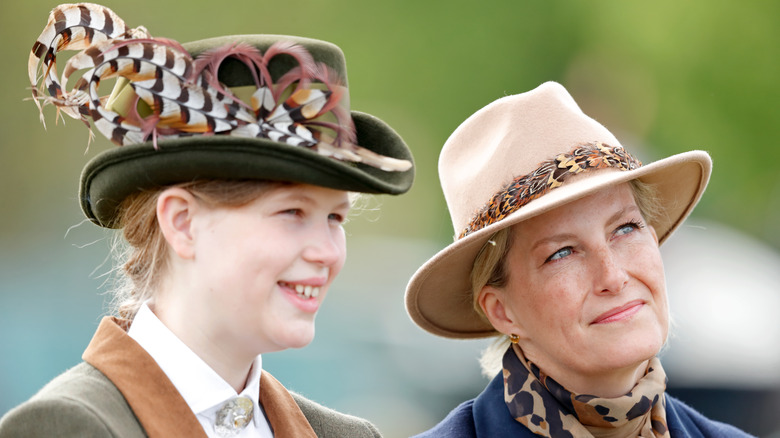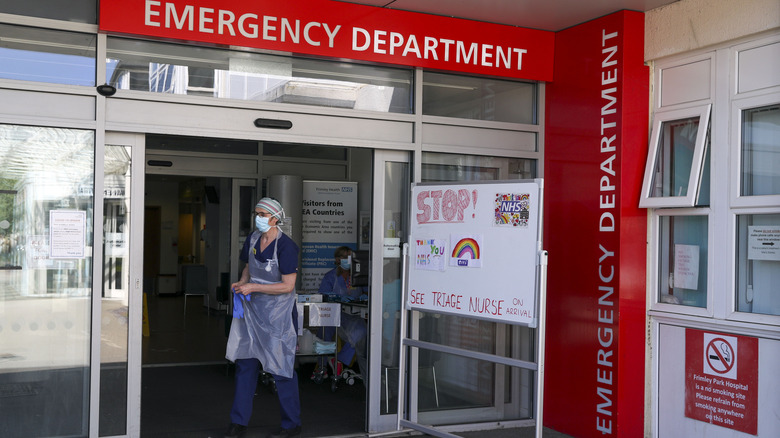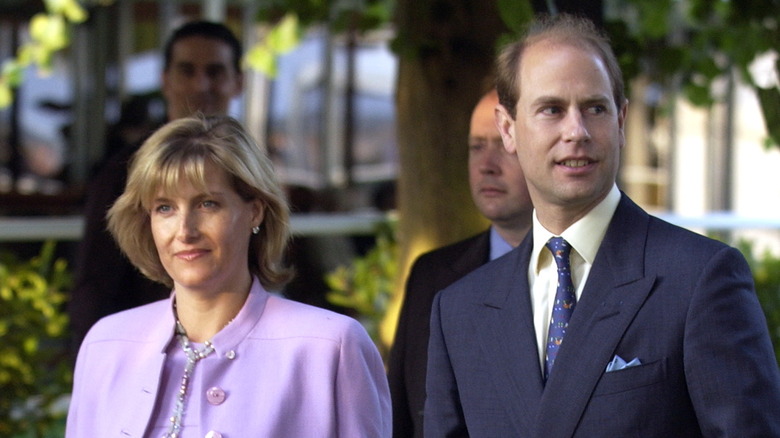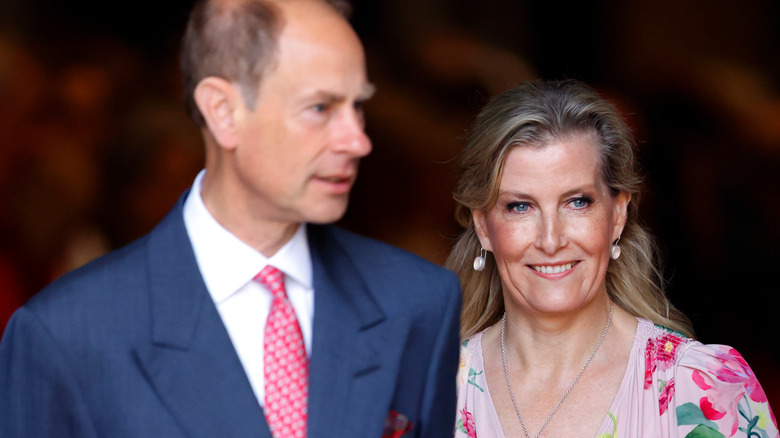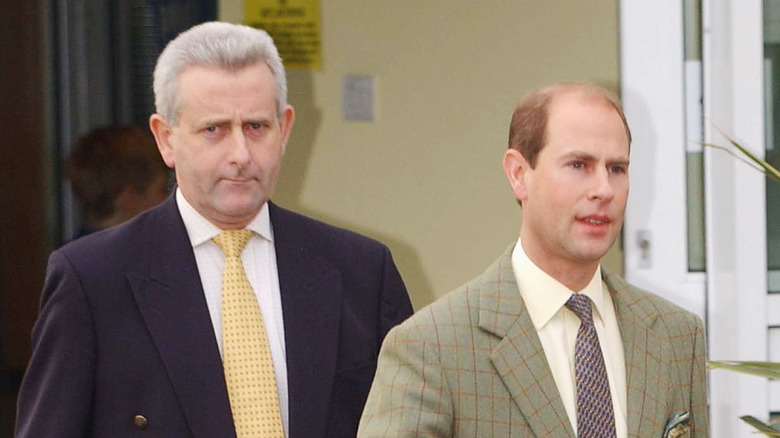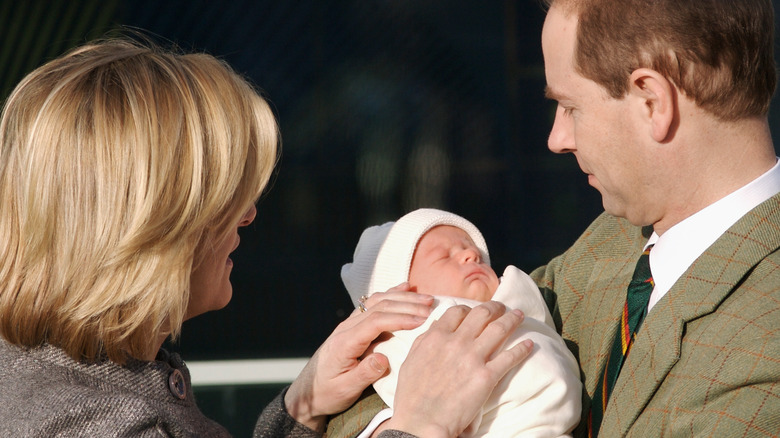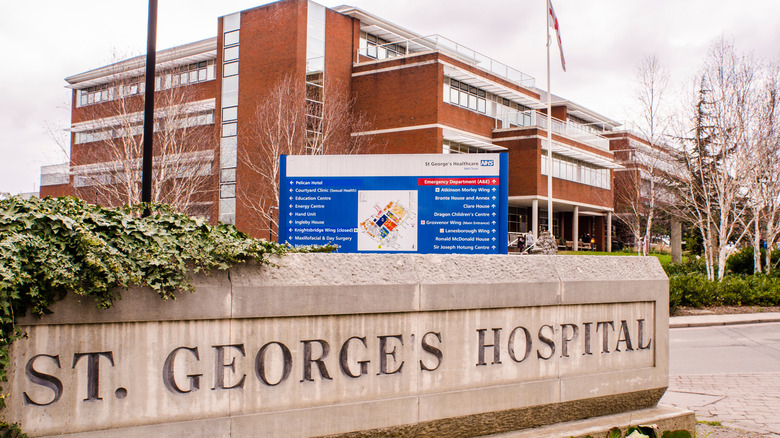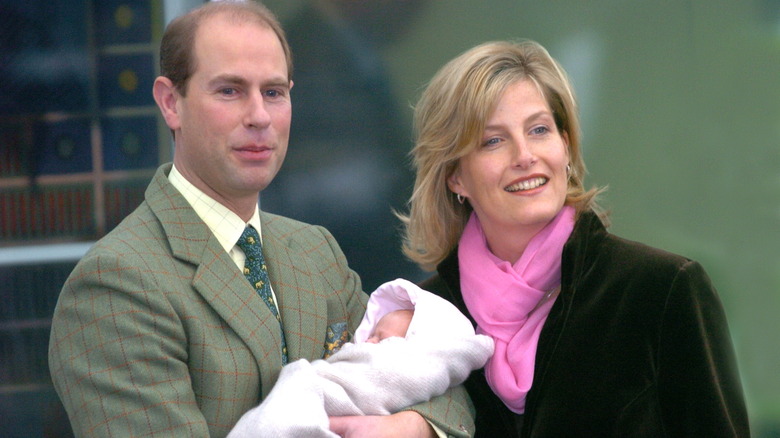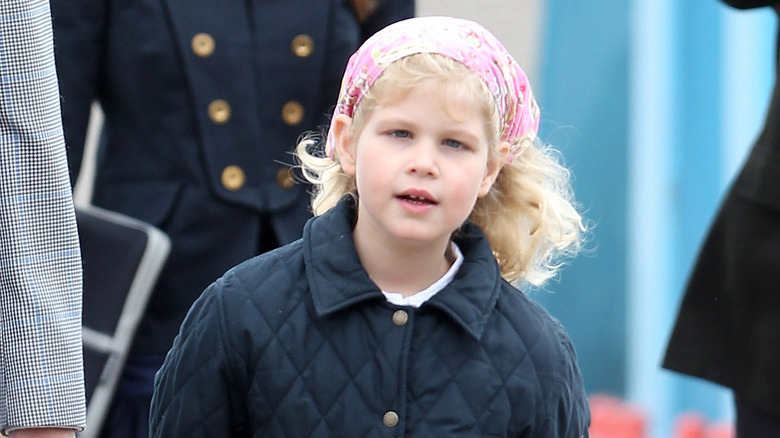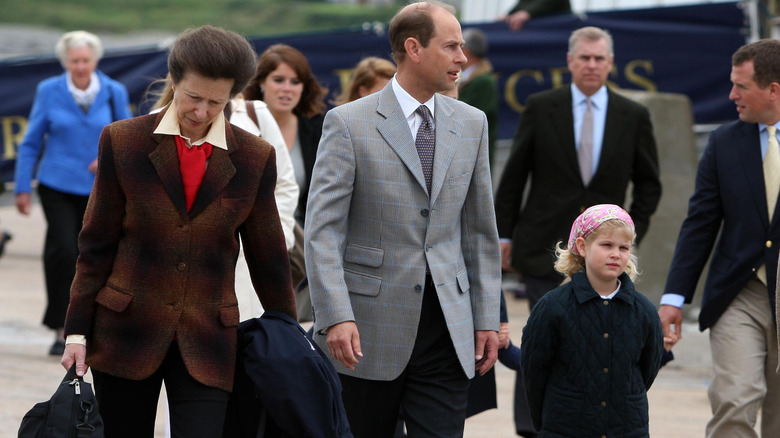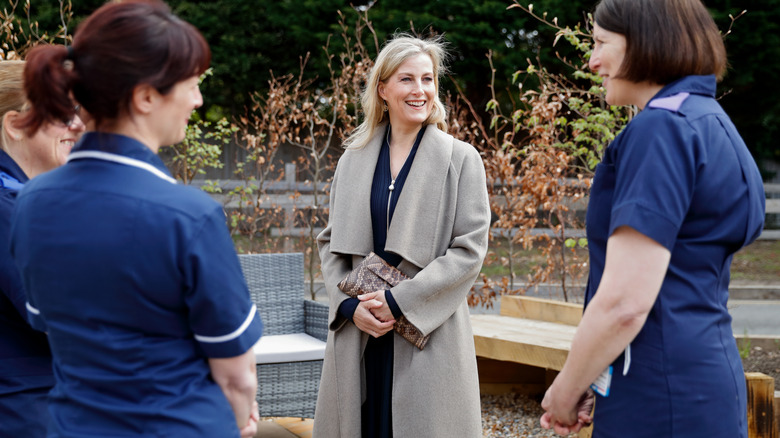All Of The Dramatic Details Surrounding Lady Louise's Birth
Life has been relatively modest and quiet for Lady Louise, who, along with her mother, Sophie, Duchess of Edinburgh, barely survived her birth. Lady Louise's father, Prince Edward, is the youngest of the late queen's children, which makes Louise the granddaughter of the late queen and the niece of King Charles III. As a young adult, Lady Louise has stepped out as a busy, healthy young member of the royal family, studying English for her undergraduate degree at St. Andrews and making royal coronation and wedding appearances.
Although the Duke and Duchess of Edinburgh can now celebrate the successful lives of their children, starting a family was not easy for them. Their desire to have a family would require a herculean will to succeed and a massive fight that resulted in an ectopic pregnancy, a tragic miscarriage, emergency surgeries, and lengthy hospitalizations.
In the end, the Duchess of Edinburgh persevered and successfully delivered the queen's new grandbaby. On top of this, Lady Louise was the very first royal grandchild to be born at an NHS hospital. Sophie survived an arduous birth experience to bring her daughter into the world, and over the years, she and her staff have opened up to share details about that terrifying day.
The hospital choice was not typical for a royal delivery
Since the Duke and Duchess of Edinburgh were first married, they have always resided in Bagshot Park, Surrey, a royal family residence located 11 miles and a 20-minute drive from Windsor. Although many of the royal mothers traditionally delivered at a royal residence or St. Mary's Hospital in London, Sophie wanted to deliver the baby close to Bagshot Park, so she chose to deliver the baby at Frimley Park NHS Hospital in Surrey, just 4 miles away.
Over the years, Edward and Sophie have been known to lead a "normal" lifestyle, and the hospital choice was an early look at how the duke and duchess would live as royals. "Another example of them wanting to do things in a non-royal way, to have normal deliveries, normal births within the NHS," historian Anna Whitelock told Express. "And in a sense, that marked out the beginning of how they wanted to bring up their children."
Sophie's choice to deliver close to home was also questionable because of the experience she had with her first pregnancy in 2001, which was ectopic, and resulted in a miscarriage. She had to be airlifted to King Edward VII Hospital where she underwent over two hours of surgery to save her life. Still, Sophie entrusted her local hospital staff to handle the task, and no one could have known that the decision to deliver 4 miles from home may have saved her life.
There was a mistake that almost cost the mother and daughter their life
Sophie, Duchess of Edinburgh, had already survived a tragic miscarriage due to ectopic pregnancy in 2001, and she was incredibly cautious leading up to the birth of Louise, canceling all events early on in the pregnancy until she was cleared to travel in June 2003. In November 2003, about four weeks before the baby was due, Sophie was supposed to be traveling to attend a Remembrance Day event with the royal family when she felt unwell and stayed home.
She began experiencing abdominal pain at her home in Bagshot Park around 6 p.m. Although the duchess wasn't expecting the arrival of the baby so early, she knew something wasn't right when the excruciating pain persisted for two hours, and at 8 p.m., she phoned for medical assistance.
Unfortunately, when she phoned for medical care, somehow the information was confused and the police were sent to Bagshot Park instead of a medical team. At the time of the call, no one understood just how dire the situation was becoming for the duchess. But as the events unfolded, it would soon become apparent that this mix-up caused a 30-minute delay in care that could have cost Sophie's life and the life of her child, who survived the night with only a few precious minutes to spare.
The life-threatening condition leading up to the birth
When Sophie, Duchess of Edinburgh, arrived at the hospital, it was discovered that she was suffering from a placental abruption, a condition in which the placenta detaches from the uterus.
About one in 100 pregnancies results in placental abruption, but the condition can range from mild to severe, in which the traumatic blood loss for the mother and loss of oxygen and blood supply to the baby can cause injury or death to the mother and child if they are not treated immediately to ensure safe delivery.
Medical staff performed an emergency cesarean section surgery to deliver the baby safely while Sophie's life hung in the balance as she slipped in and out of consciousness. It was later revealed that she had lost a life-threatening amount of blood, and her condition was so dire that she was said to be within 15 minutes of death. Despite a nearly tragic outcome, the royal family welcomed a miracle baby girl, weighing 4 pounds 9 ounces, on November 8, 2003.
Prince Edward wasn't present for the birth
On the evening of the delivery, staff attempted to reach Prince Edward to inform him of his wife's condition. He was traveling for official royal duty on the eastern coast of Africa in Mauritius, which was a 12-hour trip. Unfortunately, due to Louise's unexpectedly early arrival, the prince was not able to make it home in time for the arrival of his first child.
It also meant that the Duchess of Edinburgh endured all of the trauma surrounding Louise's birth on her own, and she remained solo for a full 24 hours before her husband could join her. On Sunday, Edward landed at Farnborough Airport, stating, "I am rather shocked at the moment, but delighted — just thrilled to bits" (via Surrey Live). He also admitted to reporters that Sophie was understandably "fraught" over the delivery. Edward would spend the next month balancing official duties with hospital visits to his new family.
Historically, royal fathers did not attend births, but Queen Elizabeth II established a new royal trend in 1964 for the birth of Prince Edward, ironically, and Prince Philip was in attendance to see his son be delivered in Buckingham Palace. By the time Lady Louise arrived in 2003, it was more common for royal fathers to be present during childbirth, and Edward's presence had been expected.
Sophie was surrounded by royal staff in her family's absence
In addition to the difficulty of Prince Edward's absence, Sophie's family also could not be reached in time for her parents to attend the birth. Instead, Sophie had the company of the queen's gynecologist, Marcus Setchell, the press secretary, Ailsa Anderson, and her courtiers.
Anderson told Hello Magazine's "A Right Royal Podcast" that Setchell called and alerted her to the emergency that was unfolding. "He said, 'I'm in a police car on my way to Frimley Park hospital. You better come.' So I thought, 'Crikey.'" Anderson also explained how the small number of delivery attendees came to be, saying: "They couldn't get a hold of her parents. So basically, it was just me and Marcus and the courtiers in the hospital. It was so dramatic."
The birth was also attended by surgeon Sukhpal Singh, gynecologist Anne Deans, and midwife Adrienne Price. Following the birth, it was reported that Sophie had very few visitors, including friends, indicating that she had a difficult recovery following the harrowing event. However, there was one very special guest, when, in a rare move, the late queen reportedly visited Sophie in the hospital.
Lady Louise was flown to a London hospital
Following the delivery and the stabilization of mother and baby, Lady Louise was flown to the neonatal unit of St. George's Hospital in London. It happened just minutes after the baby had been delivered, and the Duchess of Edinburgh was only able to see her briefly before she was transferred.
At the time, it was reported that the move to London was precautionary, according to the royal family. Premature newborns are often kept in the hospital to treat underdeveloped lungs, brain, heart, and other major organ and immune system functions.
The baby's exact condition was closely guarded during the stay at St. George's Hospital. Following a visit to their daughter at Frimley Park, Sophie's parents had very little to share, but her father, Christopher Rhys-Jones assured the BBC, "Sophie is absolutely fine. She's heavily sedated and rather sleepy but she is perfectly okay. The baby is also fine." After updating the press, the grandparents immediately traveled to London to be with their new granddaughter.
Mother and daughter had extended hospital stays
Following the birth, the royal family released the official birth announcement, stating: "Her royal highness and her daughter will remain in hospital for the foreseeable future." Soon after the birth announcement, it was reported that Sophie would stay at Frimley Park for only five days, but it quickly became clear that the birth had been quite an ordeal, and the days ticked by while both mother and daughter remained hospitalized.
As it turned out, Sophie lost 9 pints of blood the day she delivered Lady Louise, and it took significant time to recover. Edward, reportedly wearing a concerned look throughout the period, traveled back and forth between the hospital where his newborn daughter was being treated and the hospital where his wife was still recovering.
Less than a week after her birthday, Lady Louise was released from St. George's on November 14 and sent to Frimley Park, where mother and daughter could finally be together, albeit in the hospital environment. Sophie remained hospitalized until November 19, and the prince and Sophie could finally take their new baby girl home to Bagshot Park on November 23.
Lady Louise had complications from being born premature
Baby Louise had a tough start in life, having to remain hospitalized and monitored closely for the first two weeks following her birth. Lady Louise was diagnosed with an eye condition, known as esotropia, only months later. Esotropia is a condition in which underdeveloped eye muscles and nerves can cause the eyes to turn in, and the condition can cause vision difficulties and blindness.
The condition, also known as a "squint," can occur in premature babies, and may require surgical intervention to correct the affected eye and vision development. Understandably, Sophie did not want to send Louise to be hospitalized again after spending the first two weeks of her life apart following her birth but knew the surgery was necessary for Louise's development. Sophie told the Sunday Express, "Premature babies can often have squints because the eyes are the last thing in the baby package to really be finalized."
Unfortunately, the first surgery in January 2006 to correct Louise's condition was unsuccessful, and it would take several years and an additional surgery before Louise would have corrected vision. "Her squint was quite profound when she was tiny and it takes time to correct it," Sophie said in 2021. "You've got to make sure one eye doesn't become more dominant than the other but she's fine now — her eyesight is perfect."
Louise's name represents her survival
While Lady Louise was hospitalized following her birth, she was simply reported as a baby girl and did not have an official name until she was released from the hospital. Later, the family announced her official name: Lady Louise Alice Elizabeth Mary Mountbatten-Windsor. Louise was a perfect name, as it is said to mean "famous warrior," which is an excellent representation of her entrance into the world. Although her full surname is Mountbatten-Windsor, Louise has only used Lady Louise Windsor throughout her life.
Before Louise was born, Sophie and Prince Edward had already decided that none of their children would have the title of royal highness. The couple chose the name Louise after royal relatives like Louise of Hesse-Kassel and Queen Victoria's daughter, Princess Louise. Although royal names are often repeated throughout bloodlines, Louise and Princess Anne are the only two modern royals to share the name.
As royal names often do, the rest of Lady Louise's name also carries special meaning. Alice comes from Princess Alice of Greece, Prince Edward's paternal grandmother. Elizabeth has obvious ties to the late Queen Elizabeth, as well as the queen mother. Mary is Sophie's mother's name.
Sophie holds the hospital and staff close to her heart
Despite the terrifying ordeal that the Duchess of Edinburgh endured during Lady Louise's birth, Sophie had a great deal of faith in the hospital and its staff who attended the delivery. When it was time to choose the birthplace of her second child, James, Viscount Severn, in 2007, Sophie did not hesitate to choose Frimley Park again.
In 2014, the duchess attended an emotional dedication of the neonatal unit at the hospital where her children were successfully delivered. Through tears, Sophie was able to embrace Adrienne Price, the head of midwifery, who attended both births. It was easy to see that the staff and hospital meant a great deal to Sophie.
During the dedication, she acknowledged the hard work of the hospital staff and how much it meant to her and her family. "I want to say well done to everyone for your fundraising, and for all the work you do to help thousands of families — your service is the difference between life and death," Sophie said (via The Daily Mail).
